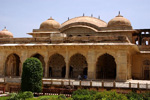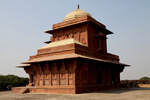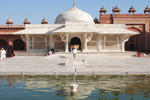|
|
|
|
 |
|
FATEHPUR SIKRI » City Details |
 |
Diwan-i-am
This structure greets visitors once they enter the complex. This used to be the place of the daily durbar, or public audience. The seat of the emperor is enclosed in an elevated area. Beautiful gardens surround this structure. It has an important place in Fatepur’s tourism. The most impressive feature of this complex is the Throne Chamber facing east. It is said that it was so built because of Akbar's belief in 'sun worship'. |
 |
| |
 |
|
Birbal's house
The house of Birbal, the favorite minister of Akbar, is an interesting structure with horizontal sunshades depicting traditional contemporary styles. It is one of the marvelous buildings of imperial Harem. It was built in 1571. It consists of fours-quare rooms, each measuring 16'-10" (5.13m) square side, all interconnected through open doorways and two oblong entrance porches on Northwest and Southeast corners. While all the four rooms, have flat ceilings, porches have triangular chhappar ceiling with pyramidal roof. The interior of the building is divided into three days by richly carved pilasters. |
 |
| |
 |
|
Jodhabai's Palace
Said to be the private quarters of the Hindu wife of the emperor, this is an entire complex in itself. The open courtyard leads to the inner chambers. The interesting features of this building are the concealed seats perched at a height to enable the women to observe the outer courtyard without being seen. |
 |
| |
 |
|
Salim Chisti's Tomb
The tomb of the sufi saint Salim is a pious spot within the complex. The building is one of the best examples of mughul architecture in India. |
 |
| |
 |
|
Pachisi Court
Pachisi is an ancient board game, very popular among the royalty of the medieval ages. This court is unique as it is said that people used to act as pawns and moved over the court following the players’ instructions. |
 |
| |
 |
|
The Agra Gate
This is the entrance to the gate. Facing Agra, this gate is typical of the gates in all mughul forts. Imposing yet intricate, this gate sets the tone as one enters the complex through it. |
 |
| |
 |
|
Naubatkhana
Naubat Khana, or Naqqar Khana (meaning the Drum House), is situated at the entrance of the palace area. Here music was played five times a day at the appointed hours. It housed a gate known as 'Hathi Pol' (Elephant Gate), where visitors dismounted from their elephants. This three storey rectangular building boasts of carved designs on its red stone walls. It is said that these carvings were originally in gold.
|
 |
| |
 |
Fatehpur Sikri Tour
Fatehpur Sikri is one of the finest examples of Mughal architectural splendour at its height. Though the city is in ruins, it is a place to visit if one comes to Agra. You can see this magnificent city with its amazing monuments of red sandstone and marble, built by the Mughal Emperor Akbar the Great, on fatehpur sikri tour. But in real terms Fatehpur Sikri is a place where one should spend some time. The sunset over the ruins is sight to cherish. Some of the grand structures at Fatehpur Sikri Tour include- The Agra Gate, Diwan-i-am, Birbal’s house, Jodhabai’s Palace, Salim Chisti’s tomb, Pachisi court, Naubatkhana and many more.
|
|
|
|
|
|
 |